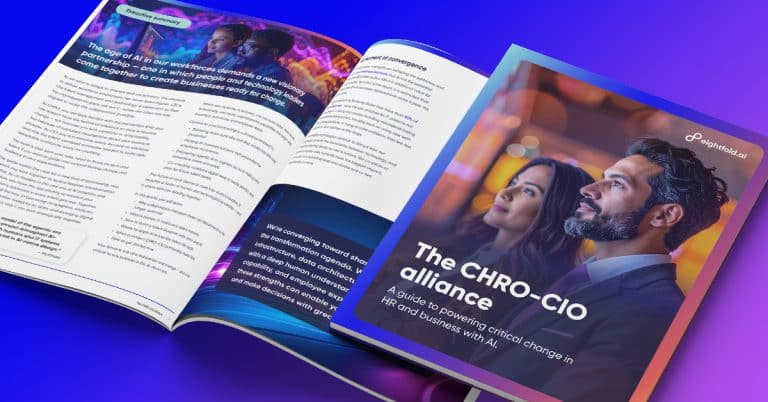
The CHRO-CIO alliance
The CHRO-CIO alliance
As the future of work accelerates, success depends on how well you connect people and technology. This guide shows you how to form a powerful CHRO–CIO alliance to drive business transformation, align data and talent strategies, and lead your organization into the agentic AI era.
You’ll learn how to:
- Build a shared AI-driven talent blueprint that aligns business, HR, and IT strategies.
- Apply agentic AI across the talent life cycle to accelerate hiring, learning, and retention.
- Create long-term alignment with shared metrics, trust, and collaboration across your C-suite.
The age of AI in our workforces demands a new visionary partnership — one in which people and technology leaders come together to create businesses ready for change.
As we race to adapt to change and uncertainty, the pressure to deliver workforce innovations has never been higher. CEOs cite talent management and technology enablement as their top organizational gaps, yet our C-suites are often not fully aligned to make this collaboration possible.
As CHRO, you are likely familiar with the perception that your role doesn’t have the technical influence to drive enterprise change — not because you lack creativity or adaptability, but because of outdated assumptions about your technical prowess. As CIO, you can become overly focused on solutions and miss the talent-centered strategies needed to build agile, adaptable workforces ready for anything.
The truth is that both your roles need to focus on tech and talent if you want to guide and support lasting change and resiliency in your organizations.
This guide makes the case for a new kind of partnership, one in which you work together to lead enterprise transformation together. As co-leaders in this new era of AI adoption and integration, you have the opportunity to reinvent your organization’s approach in every talent process. Together, you can lead the way to becoming an adaptive, analyticsdriven organization fueled by AI, data, and emerging digital capabilities — but only if you work strategically together.
When you operate in lockstep, you can move faster, think more holistically, and build organizational capabilities that align with business outcomes and employee needs.
Central to your partnership is a shared commitment to:
- Breaking down data silos that limit visibility into skills and potential.
- Piloting AI-powered solutions that personalize the employee experience.
- Embracing agentic AI to augment decision-making and streamline talent processes.
- Co-creating workforce digital twins to model, predict, and plan for future talent needs.
The future of work demands more than siloed innovation. It requires a fusion of human and technological leadership — and it starts with you leading together.
In this guide, you will learn:
- Why collaboration between these two departments is no longer optional.
- What’s broken in traditional talent models. • How to build a talent blueprint with data and AI.
- Where to apply AI across the talent life cycle. • What a modern CHRO-CIO partnership looks like.
- How to get started now.
Your future is one of collaboration and change — and one critical to any business in this AI-driven era.
A moment of convergence
AI, automation, and agility are reshaping the workforce and work itself. McKinsey estimates that AI has the potential to unlock $2.6 trillion to $4.4 trillion in additional value for organizations. Yet in that same report, it is estimated that fewer than 10% of use cases deployed ever make it past the pilot stage.
Recent research by Rand.org states that more than 80% of AI projects fail — twice the rate of failure for IT projects not involving AI — due to root causes including misunderstanding the problems being solved, focusing more on using new tech than solving problems, or trying to solve problems that are too complex for AI to address at this stage.
As emerging technologies continue to disrupt how our businesses operate, the boundaries between technology and talent are blurring. Ready-to-use solutions, like co-pilots or general-purpose tools, currently have the biggest impact, but usually on a superficial level and across one or two departments at a time.
We’re converging toward shared leadership of the transformation agenda. We need to combine infrastructure, data architecture, and AI capabilities with a deep human understanding of culture, capability, and employee experience. Together, these strengths can enable you to embrace change and make decisions with greater strategic clarity.
McKinsey supports this idea of convergence: “In the agentic era, how organizations are built and operate will evolve as much as the products or services they deliver. Work and workflows will be reimagined as AI-first, and operating models will evolve to flat networks of empowered, outcome-aligned agentic teams.”
The article continues: “The operating model of the agentic era will be anchored around reimagined AI-first workflows, with humans and IT systems selectively reintroduced in AI-native design.”
To gain the most from AI investments, you can no longer afford to innovate in silos. And at a time when 6 out of 10 workers already think of AI as a coworker, according to Deloitte, the workplace landscape is primed for change.
Evolving beyond yesterday’s talent models
Traditional talent management models were built for predictability, not agility. Long-term workforce planning, generic training programs, and rigid career ladders no longer align with how work evolves or how employees expect to grow.
And your employees feel the impact. A SHRM study on emerging professionals found that only a third of respondents expected to stay at their next role for four years or longer, but nearly two-thirds said they would commit to four or more years if they were given consistent upskilling to build in-demand competencies.
The opportunity ahead lies in integrating systems and departments, replacing rigidity with agility, and embracing human-centered strategies to personalize growth. This requires a new mindset — and the right technologies to enable it.
When you fail to work closely together, your organization faces significant risks that go beyond missed opportunities. Talent strategies may be disconnected from the technology needed to execute them, leading to fragmented systems, incomplete data, and inefficient processes. HR initiatives can stall when digital tools aren’t integrated, while IT investments may fall short if you don’t account for human-centered design and organizational culture.
You need to look out for:
Reliance on traditional talent mobility models
Rigid structures like linear career paths or onesize- fits-all learning programs can actually slow down how fast you respond to change. These may also demotivate employees who see no way to grow in ways aligned to evolving skills and roles.
Siloed HR and IT departments
When your departments are treated as separate silos, systems, data, and workflows tend to be disconnected. That means slower feedback, fragmented talent data, and gaps in digital skills infrastructure. Integrated talent management systems show strong benefits: better onboarding, more accurate skills visibility, greater internal mobility, and stronger alignment with business strategy.
Technology without human-centered design
Automating processes is good, but if those systems don’t incorporate real employee feedback, adaptability, or personalization, these risks become just another rigid framework. Employees expect learning paths and feedback loops that are customized, frequent, and responsive.
Ignoring cross-departmental responsibility for talent
Talent management doesn’t belong to HR. It touches everyone — managers, teams, technology, operations. When you delegate all talent responsibility to HR alone, you risk overloading HR and miss out on value that comes when your units work together.
The result is slower decision-making, poor visibility into skills and workforce capabilities, and missed opportunities for internal mobility or upskilling.
The impact extends to your employees and the business as a whole. Without a unified approach, learning programs may feel generic, career paths rigid, and feedback loops ineffective. Engagement drops, retention suffers, and top talent can migrate to competitors that offer a more cohesive, technology-enabled experience.
Beyond the workforce, your business risks making strategic decisions without reliable data or insight, reducing agility in the face of market change. Simply put, when you aren’t aligned, both people and technology strategies underperform, and your organization as a whole loses its ability to adapt and thrive.
You might also like...
Get the latest talent news in your inbox every month
By submitting this form, I consent to Eightfold processing my personal data in accordance with its Privacy Notice and agree to receive marketing emails from Eightfold about its products and events. I acknowledge that I can unsubscribe or update my preferences at any time.
